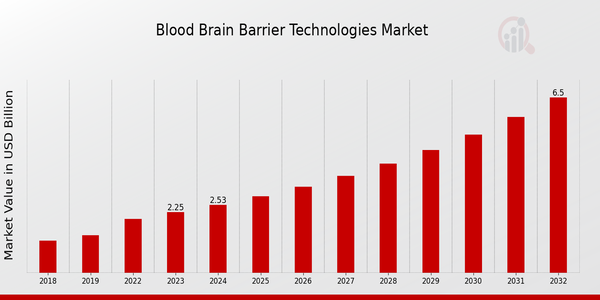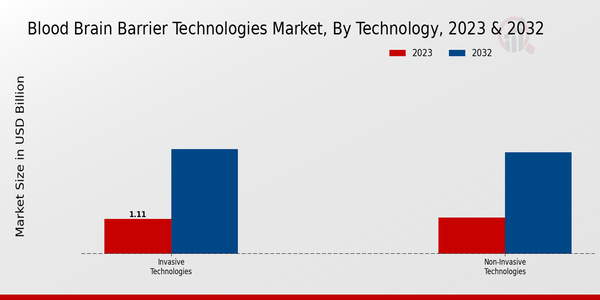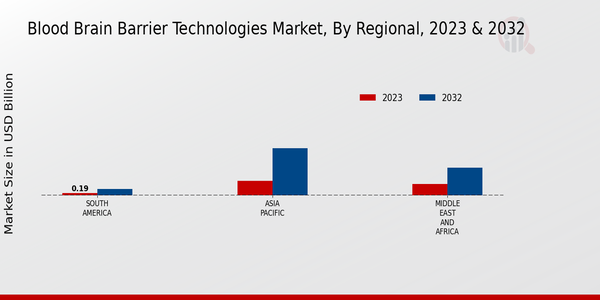Global Blood Brain Barrier Technologies Market Overview
As per MRFR analysis, the blood brain barrier technologies market size was estimated at 1.4(USD Billion) in 2023.
The blood brain barrier technologies industry is expected to grow from 1.76(USD Billion) in 2024 to 9.85(USD Billion) by 2032. The blood brain barrier technologies market CAGR (growth rate) is expected to be around 21.12% during the forecast period (2024-2032).
Key Blood Brain Barrier Technologies Market Trends Highlighted
The global market for blood-brain barrier technologies is expected to undergo significant growth in the coming years due to a range of factors. Key market drivers include the increasing prevalence of neurological diseases, the growing demand for personalized medicine, and the advancements in biotechnology and nanotechnology.
Opportunities for growth lie in the development of novel drug delivery systems, the exploration of non-invasive imaging techniques, and the integration of artificial intelligence and machine learning algorithms for personalized treatment planning.
Recent trends in the market include the increasing adoption of microfluidic devices for drug screening, the development of biomimetic platforms for BBB research, and the emergence of nanobots for targeted drug delivery to the brain. These advancements are expected to drive the market's growth and lead to improved outcomes for patients with neurological disorders.

Source: Primary Research, Secondary Research, MRFR Database and Analyst Review
Blood Brain Barrier Technologies Market Drivers
Rising Prevalence of Neurological Disorders
A major driver of the blood brain barrier technologies market is the increasing prevalence of neurological disorders such as Alzheimer’s disease, Parkinson’s disease and multiple sclerosis. These disorders affect millions of people worldwide and are a major cause of disability and death. However, many of these disorders are difficult to treat using traditional drug delivery methods because most drugs are unable to pass the blood-brain barrier.
Blood-brain barrier technologies offer a promising solution to this problem by allowing for targeted drug delivery to the brain, thereby improving treatment outcomes and reducing side effects. Blood-brain barrier is a highly complex network of cells and blood vessels that protect the brain from harmful substances in the blood.
However, it also protects the brain from many drugs, which means that using systemic drug delivery is less effective. Blood-brain barrier technologies aim to overcome this problem by using a range of approaches to enhance drug delivery across the blood-brain barrier.
These may include drug delivery systems, such as nanoparticles, liposomes and micelles, and physical methods, such as ultrasound and electrical stimulation. The high and increasing prevalence of neurological disorders, as well as the need for better, more effective treatments, are the key drivers of global demand for blood-brain barrier technologies.
The use of blood-brain barrier technologies in the treatment of a variety of neurological disorders and conditions is likely to increase, and as a result, the global blood-brain barrier technologies market is likely to grow in the future.
Technological Advancements in Drug Delivery
Technological advancements in drug delivery are another key driver of the global blood brain barrier technologies market. The development of novel drug delivery systems and technologies has enabled more efficient and targeted drug delivery to the brain.
These advancements include the use of nanotechnology, gene therapy, and cell-based therapies. Nanotechnology-based drug delivery systems, such as nanoparticles and liposomes, have shown great promise in overcoming the BBB.
These systems can be engineered to carry drugs across the BBB and release them in a controlled manner, thereby improving drug efficacy and reducing side effects. Gene therapy approaches involve the use of genetic material to modify cells in the brain, enabling the production of therapeutic proteins or the correction of genetic defects.
Cell-based therapies involve the transplantation of stem cells or other cell types into the brain to repair damaged tissue or deliver therapeutic agents. These technological advancements are expanding the possibilities for treating neurological disorders and are contributing to the growth of the Global Blood Brain Barrier Technologies Market.
Government Funding and Support
Government funding and support are vital factors in the development and commercialization of BBB technologies. Governments all over the globe have a shared recognition regarding the need to address unmet medical needs in the sphere of neurological illnesses.
Governments offer funding for research and development as well as stipulate the companies to invest their resources in BBB technologies. Such support may come in the form of grants, tax benefits, or assistance in regulatory affairs.
Being backed up by the government, companies are less exposed to the financial risks that often-times impede the R in BBB technologies. Additionally, governments seek to create a cooperative platform between academia and industry to facilitate knowledge-sharing and help the researchers to find practical applications for their findings. Government funding and support are the critical drivers for the progress of the global blood brain barrier technologies market.
Without the governments’ support, there would not be enough resources to undertake the necessary R Not only does such public funding stimulate innovation, but it also creates the suitable environment for the development of BBB technologies and their commercialization.
Blood Brain Barrier Technologies Market Segment Insights
Blood Brain Barrier Technologies Market Technology Insights
The global blood brain barrier technologies market is segmented based on technology into invasive technologies and non-invasive technologies, with invasive technologies involving direct access to the brain and non-invasive technologies not.
Invasive technologies are used to deliver drugs directly to the brain and include:
- Intracerebral Injection: Injecting the drugs directly into the brain tissue.
- Intracerebroventricular Injection: Injecting drugs into the cerebrospinal fluid within the brain’s ventricles.
- Implantation of Drug-Eluting Devices: Implanting devices that will release drugs directly into the brain over time.
Invasive technologies are very effective and allow the greatest delivery of therapeutic drugs.

Source: Primary Research, Secondary Research, MRFR Database and Analyst Review
Blood Brain Barrier Technologies Market Application Insights
The application segment is an integral part of the global blood brain barrier technologies market, defining its growth and dynamics. Neurological Disorders is the leading application segment, as the number of patients suffering from Alzheimer’s, Parkinson’s and other neurodegenerative diseases keeps increasing. In 2023, this segment accounted for around USD 1.2 billion of the total market revenue and will continue its applications saturation during the forecast period.
Oncological Disorders is the second application segment that can boast significant revenue share due to targeted drug delivery to the brain relieves which allows to treat cancer. Other applications include psychiatric disorders, infectious diseases, pain control and others.
Blood Brain Barrier Technologies Market Route of Administration Insights
The global blood brain barrier technologies market is segmented by route of administration into intravenous, intranasal, and others. Among these, the Intravenous segment accounted for the largest market share in 2023 and is expected to maintain its dominance throughout the forecast period.
The Intravenous route of administration offers several advantages, such as precise drug delivery to the target site, controlled drug release, and reduced systemic side effects. As a result, Intravenous administration is widely used for delivering Blood Brain Barrier Technologies.
The Intranasal route of administration is gaining traction due to its non-invasive nature and ability to bypass the blood brain barrier. The Others segment includes emerging routes of administration, such as intra-arterial, intracerebral, and transcranial, which are being explored for their potential to improve drug delivery to the brain.
Blood Brain Barrier Technologies Market Product Type Insights
The product type segment of the global blood brain barrier technologies market is segmented into nanocarriers, transporters, modulators, and diagnostics. Nanocarriers are expected to dominate the market in 2023, accounting for over 40% of the global revenue.
The growth of this segment is attributed to the increasing use of nanocarriers for targeted drug delivery across the blood-brain barrier. Transporters are also expected to witness significant growth, owing to their ability to facilitate the transport of drugs and other molecules across the blood-brain barrier.
Modulators, which are used to regulate the function of the blood-brain barrier, are expected to grow at a moderate pace due to their potential applications in treating neurological disorders. Diagnostics, which are used to visualize and assess the integrity of the blood-brain barrier, are expected to witness steady growth due to their increasing use in research and clinical settings.
Blood Brain Barrier Technologies Market Regional Insights
The global blood brain barrier technologies market is segmented by region into North America, Europe, APAC, South America, and MEA. North America is the largest regional segment, accounting for 38% of the global market share in 2023.
Europe is the second-largest regional segment, accounting for 28% of the global market share. APAC is the fastest-growing regional segment, with a CAGR of 14.2% from 2023 to 2032. The growth in the APAC region is attributed to the rising prevalence of neurological disorders and the increasing awareness of blood-brain barrier technologies.
South America and MEA are relatively smaller regional segments, but they are expected to witness significant growth in the coming years. The growth in these regions is attributed to the increasing investment in healthcare infrastructure and the rising demand for innovative treatments for neurological disorders.

Source: Primary Research, Secondary Research, MRFR Database and Analyst Review
Blood Brain Barrier Technologies Market Key Players and Competitive Insights
Key blood brain barrier technologies market players are involved in the process of developing strategies to promote rivalry incorporating research and development resources, expansion of the product portfolios, and integration of their units into the supply chain to meet the growing demand of the patients and adequately respond to it.
Major blood brain barrier technologies market players are collaborating with each other in the development and commercialization of novel technologies designed to enhance the drug delivery across the blood brain barrier. The market is expected to grow during the forecasting period due to the increasing incidence of neurological disorders and the high demand for effective cures.
It is expected that the market of Blood Brain Barrier Technologies will continue to show a high level of competition as there is a constant inflow of the new players entering the market as well as the existing participants constantly working on their overall share.
A company actively working on the f blood brain barrier technologies approach is Roche, a Swiss multinational healthcare company. One of the key features of Roche’s blood-brain barrier technologies is the implementation of its proprietary technology, BBB Shuttle, which is a nano-sized delivery system.
Apart from that, Roche has a vibrant internal research and development department, which is working on constant improvement of existing technologies and development of new candidates. The application of its own technologies in the products offered and development of multiple candidate products make Roche one of the key players on the market of Blood Brain Barrier Technologies.
Another company is AbbVie, an American biopharmaceutical company. AbbVie has a strong interest in the development of cures for a variety of neurological diseases and is currently working on the implementation of multiple technologies in the segment.
AbbVie has applied its proprietary c-Met antibody, which has been shown to be highly effective for the enhanced delivery of various therapeutic molecules to the brain. AbbVie is also involved in the research and development process, and it has multiple candidates in the corporate pipeline.
Key Companies in the Blood Brain Barrier Technologies Market Include
- Eli Lilly and Company
- Baxter International
- AstraZeneca
- Sangamo Therapeutics
- Merck & Co.
- Akari Therapeutics
- Transthyretin Therapeutics
- Sanofi
- Pfizer
- Alder Biopharmaceuticals
- CTI Life Sciences
- Zydus Pharmaceuticals
- Novartis
- Elbion
- Hoffmann La Roche Ltd.
Blood Brain Barrier Technologies Market Developments
The blood brain barrier technologies market is projected to reach USD 9.85 billion by 2032, exhibiting a CAGR of 21.12% during the forecast period (2024-2032). Increasing prevalence of neurological disorders and rising demand for targeted drug delivery to the brain are driving market growth.
For instance, according to the World Health Organization (WHO), neurological disorders affect over 1 billion people worldwide, and this number is expected to rise in the coming years.
Recent advancements in nanotechnology and biotechnology have led to the development of novel Blood Brain Barrier (BBB) technologies that can effectively deliver drugs to the brain. Key players in the market are focusing onand collaborations to develop and commercialize these technologies.
For example, in 2023, AbbVie and Roche entered a collaboration to develop and commercialize BBB-penetrating antibodies for the treatment of neurological disorders.
Blood Brain Barrier Technologies Market Segmentation Insights
Blood Brain Barrier Technologies Market Technology Outlook
- Invasive Technologies
- Non-Invasive Technologies
Blood Brain Barrier Technologies Market Application Outlook
- Neurological Disorders
- Oncological Disorders
- Others
Blood Brain Barrier Technologies Market Route of Administration Outlook
- Intravenous
- Intranasal
- Others
Blood Brain Barrier Technologies Market Product Type Outlook
- Nanocarriers
- Transporters
- Modulators
- Diagnostics
Blood Brain Barrier Technologies Market Regional Outlook
- North America
- Europe
- South America
- Asia Pacific
- Middle East and Africa
| Report Attribute/Metric |
Details |
| Market Size 2023 |
1.4(USD Billion) |
| Market Size 2024 |
1.76(USD Billion) |
| Market Size 2032 |
9.85(USD Billion) |
| Compound Annual Growth Rate (CAGR) |
21.12% (2024-2032) |
| Report Coverage |
Revenue Forecast, Competitive Landscape, Growth Factors, and Trends |
| Base Year |
2023 |
| Market Forecast Period |
2024-2032 |
| Historical Data |
2019-2023 |
| Market Forecast Units |
USD Billion |
| Key Companies Profiled |
Eli Lilly and Company, Baxter International, AstraZeneca, Sangamo Therapeutics, Merck & Co., Akari Therapeutics, Transthyretin Therapeutics, Sanofi, Pfizer, Alder Biopharmaceuticals, CTI Life Sciences, Zydus Pharmaceuticals, Novartis, Elbion, F. Hoffmann La Roche Ltd. |
| Segments Covered |
Technology, Application, Route of Administration, Product Type, Region |
| Key Market Opportunities |
1. Targeted Drug Delivery 2. Improved Treatment Strategies for Neurological Disorders 3. Advancements in Brain Imaging Techniques 4. Personalized Medicine 5. Gene Therapy |
| Key Market Dynamics |
1. Aging Population 2. Increasing Prevalence of Neurological Disorders 3. Advancements in Drug Delivery Systems 4. Nanotechnology-based Developments 5. Growing Government Initiatives |
| Countries Covered |
North America, Europe, APAC, South America, MEA |
Frequently Asked Questions (FAQ) :
The global blood brain barrier technologies market is expected to be worth 1.76 billion USD in 2024.
The global blood brain barrier technologies market is projected to grow at a CAGR of 21.12% from 2023 to 2032.
The global blood brain barrier technologies market is expected to reach 9.85 billion USD by 2032.
North America is expected to hold the largest share of the global blood brain barrier technologies market in 2032.
The treatment of neurological disorders is expected to drive the growth of the global blood brain barrier technologies market.
The key competitors in the global blood brain barrier technologies market include Roche, Merck, and Pfizer.
The challenges faced by the market include the high cost of development and the regulatory hurdles.
The opportunities for the global blood brain barrier technologies market include the growing prevalence of neurological disorders and the increasing investment in research and development.
The key trends in the global blood brain barrier technologies market include the development of new delivery systems and the increasing use of nanotechnology.
The regulatory landscape of the global blood brain barrier technologies market is complex and varies from country to country.

















